Lately I’ve been kicking around various thoughts on upgrading my computer, an Intel Core 2 Duo-based system pushing three years old. It began with upgrading my video card from a Geforce 8800GTS to a Radeon HD 4890, but I was met with lackluster performance despite the fact that the new card should smoke the old one. Obviously, I had other limitations, and this simply would not stand.
It took me several more weeks of research, but soon it was decided. I would no longer be upgrading; I would be replacing. The advent of the new Intel LGA 1156 socket meant I would not be simply adding a processor and RAM, but also a new motherboard and a new power supply. When all was said and done, the only part remaining from my old computer was an ASUS DVD burner.
At first, I was planning to use the Core i5-661 for its 3.33 GHz clock speed, but when I realized I could save almost half on the Core i3-530 and only lose 400 MHz, it was a no-brainer. I was fine with the lesser speed, especially with the excellent overclocking capabilities of the Core i3-530.
I felt like I took a bit of a leap with the ASRock motherboard, RAIDMAX power supply, and G.SKILL memory. I had never used any of these brands before, but for the most part, the reviews for all were promising, and RAIDMAX and G.SKILL are rather well-known amongst gamers. (As a side note, customer reviews on practically any computer part will make you nervous.)
Finally, I had the build locked in and I placed the order.
| Chassis | Cooler Master Centurion 5 |
| Power supply | RAIDMAX Blackstone 750W |
| Motherboard | ASRock H55M Pro |
| CPU | Intel Core i3-530 @ 2.93 GHz |
| RAM | G.SKILL Ripjaws DDR3 1600 MHz |
| Graphics card | XFX Radeon HD 4890 |
| Hard drive | Western Digital Caviar Black 750 GB |
Quick note: Up until the last moment, I had planned to use my old IN-WIN Z611T case for the new build, but ended up deciding to get a new case for better airflow and cooling right before placing the order. Only a day later did I realize I purchased a full size case and a micro ATX motherboard. Oops! Of course the micro ATX board will still work just fine in the full size case, it just feels like a missed opportunity.
The parts all came in one box (except for the case of course.)
I immediately opened up the Cooler Master Centurion to get to work. The case uses an easy to use screwless design, though the expansion slot snaps are rather flimsy. Optical and disk drives are held secure by sliding plastic clips.
The RAIDMAX power supply is modular, but just like my last experience with a modular PSU, I ended up using all but one of the cables. I do like that it has smaller “tails” protruding from the casing instead of sockets embedded in the side to attach the modular cables, making it easier to manage when already installed in the case.
The large 135mm fan has blue LEDs built into it if you’re into that sort of thing, and I will shamefully admit that the blue glow inside my computer is kind of nifty.
After getting the power supply and motherboard installed, I had a little laugh at the micro ATX board sitting in that big case, and also encountered a pretty large (though easily worked around) design flaw in the case; the front case fan cable is stupidly short. Stretched to its fullest, it was still a good inch and a half too short to reach the fan header and I was forced to use the included 3-pin fan power to 4-pin Molex power adapter and an entire extra modular power cable.
The rest of the build went smoothly, and I was pleasantly surprised by the video card’s clearance. A card of this size will block one of the 3.5″ bays, but there are four more available; more than enough for me.
After installing Windows 7 64-bit and getting drivers installed, I, of course, went straight for Crysis, which not only got a poor framerate on my old machine, but even with low graphics settings for higher framerates, it would be frustratingly jittery, presumably due to the dynamic loading of textures and models. None of this was to be seen anymore.
While I didn’t run a proper Crysis benchmark, the first two levels were pretty consistent mid-30s FPS (and no stuttering!) at 1680×1050 resolution, DX10 mode, all settings “very high”, no AA/AF. Perfectly playable.
For a proper benchmark through 3DMark 2006, a comparison between the two machines:
CPU: Intel Core i3-530 @ 2.93 GHz
Motherboard: ASRock H55M Pro
RAM: G.SKILL Ripjaws DDR3 1600 MHz
Video: XFX Radeon HD 4890
3DMark score: 14274
vs.
CPU: Intel Core 2 Duo E6550 @ 2.33 GHz
Motherboard: Intel DG33BU
RAM: Kingston ValueRAM DDR2 667 MHz
Video: Foxconn Geforce 8800GTS 320 MB
3DMark score: 8757
That’s good enough for me!

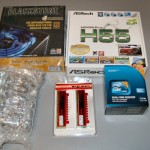
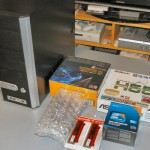
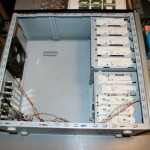
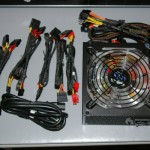
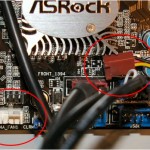
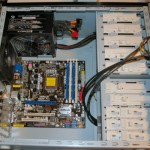
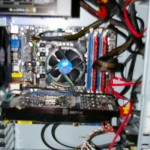
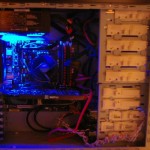
One comment on “Building a New Gaming Computer”
Comments are closed.